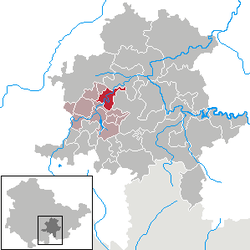Schwarzburg (municipality)
| Schwarzburg | ||
|---|---|---|
 | ||
| ||
 Schwarzburg | ||
Location of Schwarzburg (municipality) within Saalfeld-Rudolstadt district  | ||
| Coordinates: 50°38′27″N 11°11′49″E / 50.64083°N 11.19694°ECoordinates: 50°38′27″N 11°11′49″E / 50.64083°N 11.19694°E | ||
| Country | Germany | |
| State | Thuringia | |
| District | Saalfeld-Rudolstadt | |
| Municipal assoc. | Mittleres Schwarzatal | |
| Government | ||
| • Mayor | Knut Künzer | |
| Area | ||
| • Total | 14.63 km2 (5.65 sq mi) | |
| Population (2015-12-31)[1] | ||
| • Total | 560 | |
| • Density | 38/km2 (99/sq mi) | |
| Time zone | CET/CEST (UTC+1/+2) | |
| Postal codes | 07427 | |
| Dialling codes | 036730 | |
| Vehicle registration | SLF | |
| Website | www.mittleres-schwarzatal.de | |
Schwarzburg is a municipality in the valley of the Schwarza (German: Schwarzatal) in the district Saalfeld-Rudolstadt in Thuringia, Germany.
First mentioned in 1071 as Swartzinburg. The (now-ruined) castle was from the 12th century the seat of the Counts of Schwarzburg. Then Rudolstadt became seat of the new line of Schwarzburg-Rudolstadt.
On August 11, 1919, while on holiday in Schwarzburg, Friedrich Ebert — the first Reichspräsident of Germany — signed the Weimar constitution, the first democratic constitution of Germany.
References
This article is issued from Wikipedia - version of the 9/3/2015. The text is available under the Creative Commons Attribution/Share Alike but additional terms may apply for the media files.
